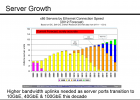Sovillo evaluates mobile-readiness of websites using industry best practices & standards.
Why Mobilize?
 |
Read the website without zooming. | |
 |
Easily find contact information. | |
 |
Navigate through the site without pushing the wrong button. |
A mobile optimised site can improve your ranking on search engines when searching from mobile devices.
Mobile’s overall share of Web traffic in the United States has increased to about 9% (according to StatCounter) which is also the same percentage of Quantcast’s Top Million sites that are deemed ready for mobile in 2012 according to data from the Mongoose Metrics Data Series.
Since there wasn’t the same data pull last year, it could be compared loosely to data from Brand Anymore in late 2010, which determined that of 7,000 retail websites only 4.8% were mobile ready – a nearly doubling of the Web’s mobile readiness in a year.
In the Mongoose Metrics data set, 118,000 of the 1,000,000 sites could not be crawled for a variety of reasons, resulting in approximately 882,000 sites that could be used for this data.
As 79,133 sites either rendered a mobile version on the same URL or redirected to a mobile version of the site under a different URL when a smartphone user agent was detected, this number dropped to 76,241 when a feature phone user agent was used.
Interestingly, these sites used a JavaScript mobile redirect more often for feature phones than smartphones.
The two user agent types being used were the same that Google uses to determine a site’s rendering for the two mobile phone types.
Why this is important is due to consumers preferring a mobile website over an app for price comparisons, reviews and actual purchases on their mobile device, according to the results of Adobe’s Mobile Experience Survey in 2011, which means they are most likely to use a search engine.







